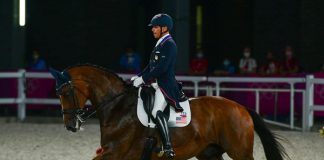 Few things can be more frustrating to a rider working with a green horse than trying to figure out and fix problems with head carriage. The list of evasive mouth issues is long. One example is a horse that’s behind the bit, which means he avoids contact with the bit and the rider’s hands by over flexing at the poll until his chin is nearly on his chest. Another example is a horse that escapes the bit by telescoping his neck until he looks like a giraffe. Then there’s the physically exhausting horse that leans on the bit, pulling against the rider’s hands and arms.
Few things can be more frustrating to a rider working with a green horse than trying to figure out and fix problems with head carriage. The list of evasive mouth issues is long. One example is a horse that’s behind the bit, which means he avoids contact with the bit and the rider’s hands by over flexing at the poll until his chin is nearly on his chest. Another example is a horse that escapes the bit by telescoping his neck until he looks like a giraffe. Then there’s the physically exhausting horse that leans on the bit, pulling against the rider’s hands and arms.
Flatwork exercises that encourage a horse to bend and move laterally through turns will make him more supple, especially through his head, neck and shoulders. As he loosens up in his front end, he will become softer in the mouth. Upward and downward transitions from one gait to another encourage the horse to shift his weight and balance from his front end to his hindquarters. Once the horse begins to collect his stride he will lean less on the rider’s hands for support and become lighter and more responsive. Throughout the horse’s training, however, the rider must reward the horse for any signs of improvement by softening contact with his mouth.
Read more about developing good hands in the May 2010 issue of Horse Illustrated. Click here to subscribe.






Great article! So nice to see that it encourages soft forgiving hands, proper bit selection, and most importantly, PATIENCE! I’ve been working on my OTTB’s “headset” for a long time. He always carried it up in the air. Finally the other day he figured out what I wanted, dropped it down and relaxed! What a huge accomplishment! I believe that too many people are impatient and use draw reins as a crutch.
Transitions are great, but they have to be done properly. By getting the horse to lift his/her shoulders, he/she can carry themselves. A horse who is avoiding the bit has no self carriage. Once a horse is lifting and moving the shoulders, then the head will come down and the proper muscles will build. By NOT having contact on the bit the horse has to carry themselves and doesn’t rely on their crutch to support them (YOU!).
I really like this article~ I have a horse with this problem. He holds his head high in the air and it is hard to use the right aids and paterns of aids to get him to sofen up and put his head down to loosen the martengailes hold on his head. When he actually does soften up and I give him some slack as a reward, as soon as I do anything else like direct him or try to go on a circle he automaticly tenses up and puts his head high in the air and I have to go all the way back to step one! I shall try some of the tips and see if I can get him to soften up a little more. Thank you for the help~